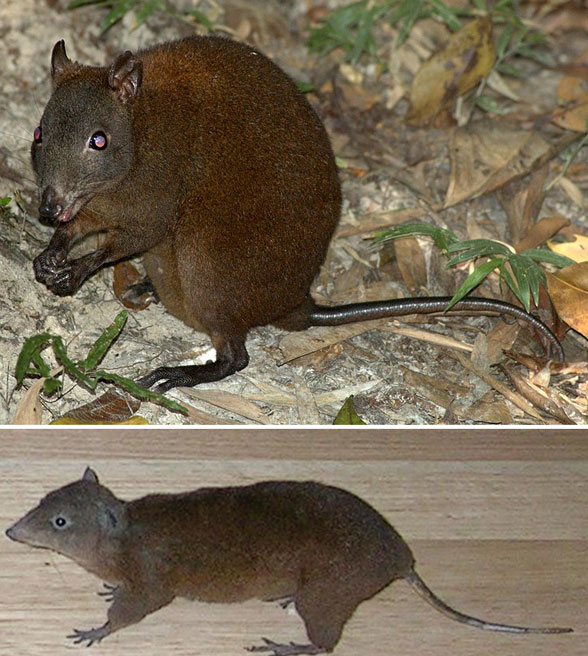In 1998 Burk, Westerman and Springer
united kangaroos and rat-kangaroos, like newly added Hypsiprymnodon (Fig 1) based on traits. Everyone agrees. Even the LRT agrees.
Burk, Westerman and Springer reported,
“Unlike other macropodids, however, which are capable of bipedal hopping, Hypsiprymnodon is a quadrupedal bounder and lacks several derived features of the pes and tarsus that are presumably adaptations for bipedal hopping.”

After testing
the large reptile tree (LRT, 2145 taxa, subset Fig 1) nests kangaroos and rat-kangaroos together. Even though Burk, Westerman and Springer excluded fossil taxa, this time that did not matter.
Fossil interatheres
are the sister taxa to potoroos and kangaroos in the LRT. That’s not yet widely recognized as a hypothesis of interrelationships.
Burk, Westerman and Springer reported,
“Parsimony, minimum evolution, maximum likelihood, and quartet puzzling analyses with
mtDNA sequences demonstrate that Hypsiprymnodon is quite divergent from other members
of the Macropodidae.”
That seems to be so, simply because Hypsiprymnodon is primitive. More primitive proximal taxa (Fig 2) are only known from fossils. However much more primitive ancestors that appeared during the Jurassic prior to the break-up of Gondwana, like Dromiciops, are still extant.
Hypsiprymnodon moschatus
(Ramsey 1876, snout-vent up to 27cm) isthe extant musky rat-kangaroo, restricted to NE Australia. This omnivore is traditionally allied with potoroos, like Potorous. The last premolars converge with those of multituberculates, like Ptilodus (above).
References
Beck RMD, Voss RS and Jansa SA 2022. Craniodental morphology and phylogeny of marsupials. Bullein of the American Museum of Natural History 457:350pp.
Bradshaw D and Bradshaw F 2012. The physiology of the honey possum, Tarsipes rostratus, a small marsupial with a suite of highly specialised characters: a review. J Comp Physiol 182(4):469-89. doi: 10.1007/s00360-011-0632-9.
Burk A, Westerman M and Springer M 1998. The phylogenetic position of the musky rat-kangaroo and the evolution of bipedal hopping in kangaroos (Macopodidae: Diptrodontia). Systematic Biology 47(3):457–474.
Gervais P and Verreaux J 1842. L’Institut, l’ere Section, Sci., Math, Phys., Nat. :427 p.75
Kerr J 1792. Animal Kingdom: 198.
Ramsay EP 1875. Description of a new genus and species of rat kangaroo, allied to the genus Hypsiprymnus, proposed to be called ‘Hypsiprymnodon moschatus‘. Proceedings of the Linnean Society of New South Wales. 1: 33–35.


